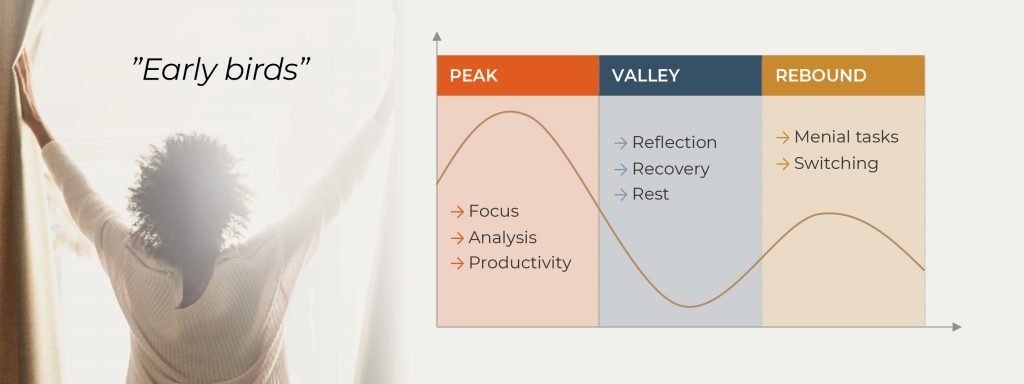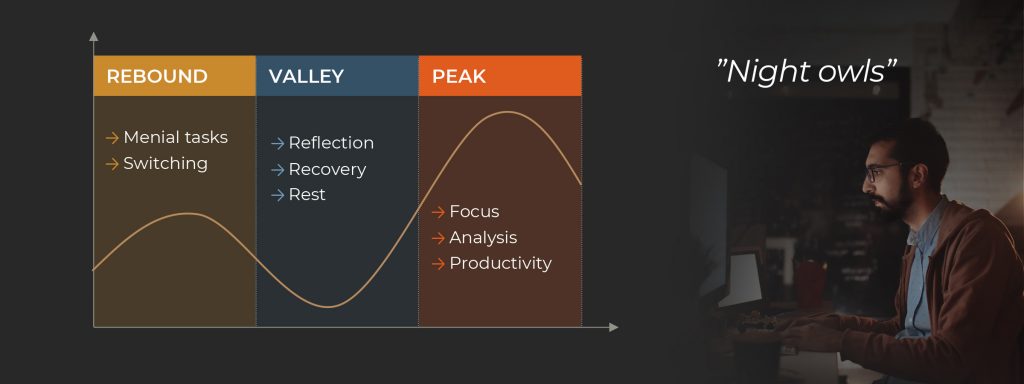Find Your Perfect Daily Rhythm to Boost Your Performance

The human body and brain follow daily rhythms, potentially making different parts of the day better suited to some activities, relative others. Improving your understanding of these rhythms, and your own pre-dispositions to them, could help your improve both your health and performance.
Research suggests that 1 in 8 people around the world are working more than 50 hours per week. That’s more than 10 hours per working day, but there is an important threshold just below this point: working more than 48 hour per week appears to be associated with a range of negative health outcomes including depressed mood & stress, sleep conditions, & coronary heart disease.
Regardless of the length of your day, the distribution of work and rest during our waking hours is fundamental to both performance and wellbeing. Cognitive performance can vary by 20% during the average day, and this variation makes different parts of the day better suited to some activities, more than others.
Find Your Own Rhythm
The majority of the population can be classified as ‘morning-types’. They generally experience their peak period closer to the beginning of the day. A smaller proportion of the population experience their peak later in the day, and everyone else falls somewhere in-between. You could imagine the day as divided into three phases, a peak, valley and a rebound, each with distinct characteristics.

Peak cognitive time, whether it arrives in the morning, or later in the day for you, is a great opportunity for work that requires focussed attention. Try to schedule your ‘high cognitive gear’ tasks for this period, and during this time, create some positive time pressure. Even if you only have 1 hour available for high cognitive gear work, experiment with working 25 minutes ‘on’, followed by a 5-minute break, then repeat. During your 5-minute break, step away from your desk, and avoid looking at another screen. Perhaps look out of the window, instead.
Following this brief pause, try to focus again, for another 25 minutes. Also, during your peak period, engineer your environment for focus. Even the presence of your smartphone can negatively affect two measures of cognitive performance: working memory capacity and functional fluid intelligence, in particular. Put your phone away for a few minutes, lock yourself in a room if you need to, and consider getting some noise cancelling headphones.

Learn to Recover
During the ‘valley’ period in your day, it’s likely that you may feel slightly fatigued, so listen to your brain and your body. This is a good time for a lunch break. While common in Finland (the home of Hintsa Performance), the lunch break went ‘extinct’ in the UK, a long-time ago, with most people grabbing a sandwich and eating it at their desk, if they’re lucky. If your last lunch-break is a distant memory, revive the practice.
Optimum recharging conditions vary from person to person. If you would describe yourself as an introvert, perhaps go for a walk, on your own during the valley in your day. Those who consider themselves to be more extrovert may prefer to spend time with colleagues. Whatever the case, try to choose an activity for ‘valley time’ which will leave you feeling replenished at the end of it.
Whether or not you are boosted by your own company, or others, try to get some bright, natural light during the morning and toward the middle of the day. This can help to maintain a healthy and stable circadian rhythm (body clock), and may improve your sleep.
Turn Your Distractibility Into a Strength
In the rebound, people find that they are generally more pre-disposed to switching between tasks, and perhaps more vulnerable to distraction. This may be related to reduced ‘inhibition’ or impulse control. However, this isn’t necessarily a bad thing. Use this switching time to complete smaller tasks that require less focused attention. Also, be open to new insights, and spend some time noting down any new ideas which emerge. Reduced inhibition, while challenging for focused high-gear work, may be associated with a greater openness to new perspectives.
Take the Perfect Nap
There is one more top-tip to super-charge your workday, whether you’re a Formula 1 driver or Fortune 500 CEO: napping. Back in the 1990’s the FAA, the United States’ Federal Aviation Administration, and NASA, collaborated on a multi-year research project to discover the science of the perfect nap. If you have the opportunity, a 25.8-minute nap has been scientifically proven to increase alertness by 50% and subsequent task-performance by 34%.
There is one more top-tip to super-charge your workday, whether you’re a Formula 1 driver or Fortune 500 CEO: napping.
Finally, once you get home, consider how you switch off from work. Knowledge work is characterised by non-routine hours, and it’s almost inevitable that some work is completed at home. Bringing work home is not necessarily a bad thing. It can bring a greater sense of autonomy – being able to complete work at your own pace, outside of the constrains of the office – and focus, providing the opportunity to lock yourself away, without the distractions of colleagues or clients. However, this ‘after-hours connectivity’ can come at the expense of recovery. In particular, it seems that higher levels of after-hours connectivity – writing and answering e-mails, phone call, meetings and other substantive work outside of ‘normal’ working hours, reduces our experience of detachment; being able to switch off from work.
Even if it’s just for a few minutes, try to spend some time focussing on recovery at the end of the day. You can also prepare yourself during the day, to improve your ability to detach from work, later on. The following list provides 5 ideas to help you to switch off.
- Create an unwinding ritual (train your brain to slow down).
- Take regular breaks during the day (practise switching off).
- Schedule recovery activities (guard against mind switching back to work).
- Spend time on an activity that is the opposite to work (cycling vs. screen time).
- Rediscover hobbies (do something that absorbs you).
Daily rhythms of work and rest are the foundation for better health, wellbeing and sustainable high performance. High-performers, in both sport and business, make it a habit to work hard, and recover harder. See also our previous articles about seasonal rhythms and weekly rhythms and find out how they can help you perform better.
Interested in hearing more about our coaching services? Leave your contact details below and we’ll be in touch.



